Out... In 17 Days
TIME Asia/Pacific: 22 August 1988
Burma's Sein Lwin falls after a week of protest and bloodshed
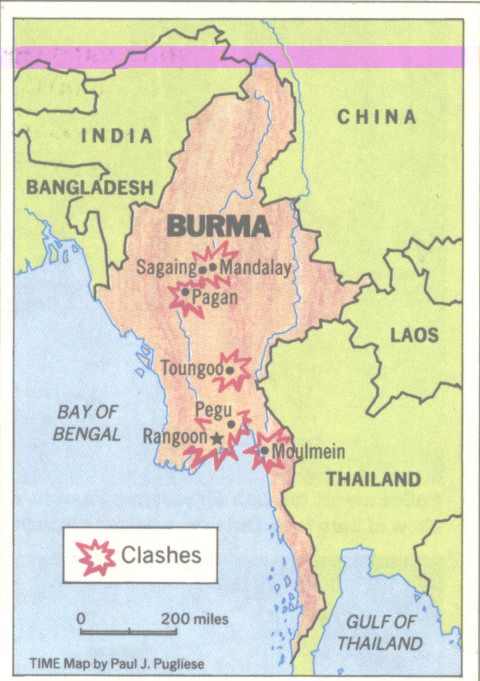
From Mandalay in the central plain to Moulmein on the Andaman Sea, Burma burst into flame last week, the spark provided by protest and bloodshed, the oxygen by rumor. In Sagaing, a city of 70,000 in the center of the country, security forces opened up with shotguns on an antigovernment crowd of 5,000 that was converging on a police station, and 31 people were reported killed. In the suburbs of Rangoon, the capital, three policemen were said to have been beheaded by an enraged mob. Word of mutinies by military units in the north and east flickered through the country like fire on a trail of gunpowder. In Rangoon protesters against the regime of recently installed President Sein Lwin begged car drivers for gasoline with which to make Molotov cocktails, while others pleaded with government troops to join them, even importuning the soldiers by kissing their feet. Still others marched through the streets in grisly corteges, bearing aloft the bodies demonstrators killed by security forces.
For five days last week, violence engulfed much of Burma, a country peopled by devout Buddhists averse to bloodletting, in a spontaneous eruption of discontent that rocked a despised government to its foundations. Then, just as the surge of clashes ebbed slightly -- as if both sides were catching their breath -- the protesters won what they had sought: the resignation of President Sein Lwin, a hard-line retired general who had succeeded longtime Strongman Ne Win only 17 days earlier.
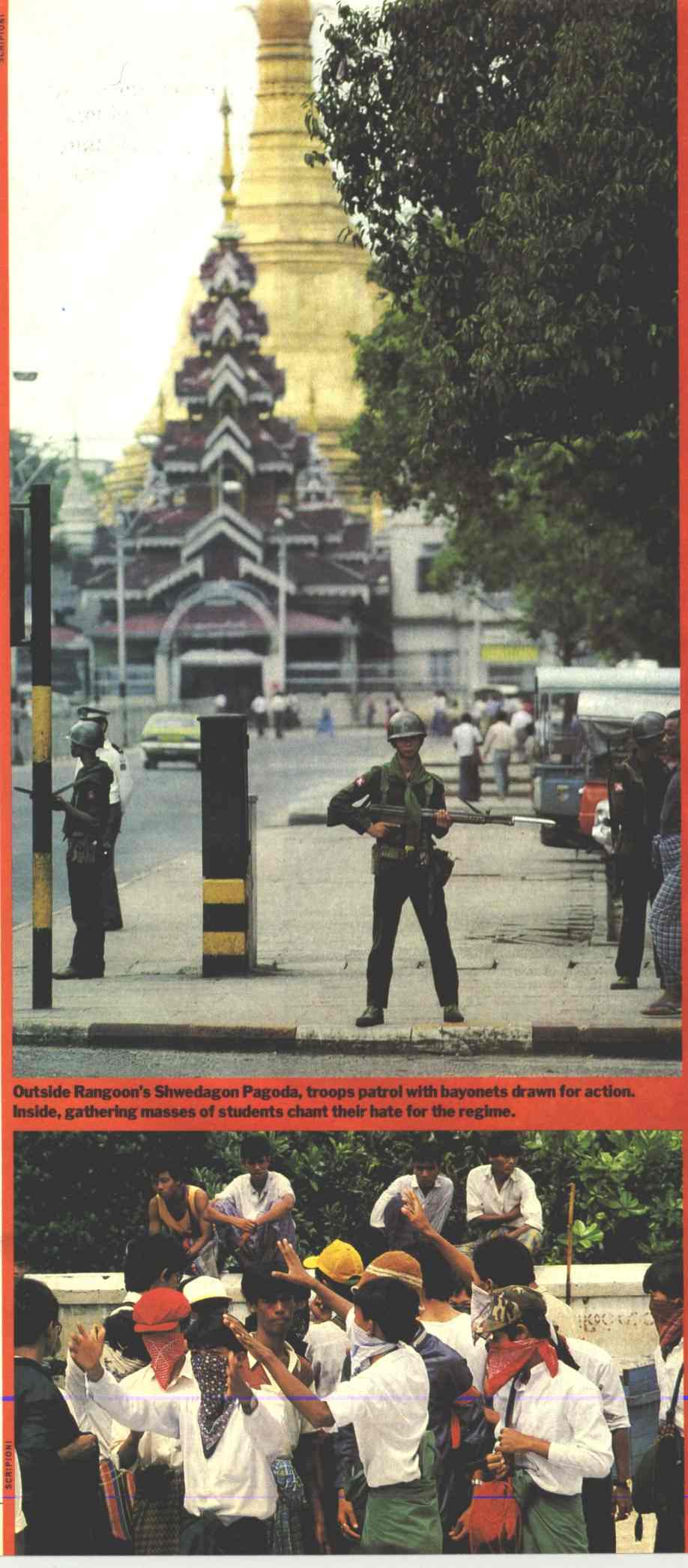
No explanation accompanied Radio Rangoon's announcement, beyond a brief mention that Sein Lwin, 64, had also given up the powerful chairmanship of the Burma Socialist Program Party, the country's sole political organization. Who would take his place remained a mystery by week's end, but there was speculation that General Kyaw Htin, a respected former chief of staff and Defense Minister, was among those in control; it was he how had signed the resignation announcement.
The week's upheaval left Burma's 38 million people in a volatile though temporarily quieted state. While the makeshift barricades that had sprung up in Rangoon were being dismantled, the B.S.P.P. was still confronted with an opposition at once broadbased and emboldened by success. Desperately grasping for its crumbling legitimacy, the party announced a special meeting of its Central Committee and of the People's Assembly this Friday to address the crisis. Among observers in Rangoon, a wary optimism prevailed about the country's prospects."There is small glimmer of hope after years gathering darkness" was the way one Western diplomat put it. "Maybe the country has turned a corner -- and that's a big maybe."
By the time Sein Lwin fell, the official death toll in the disturbances that flared through two dozen cities and towns had risen to 98, though foreign diplomats in Rangoon multiplied the figure several fold. Unofficial estimates held that more than 1,000 protesters had been killed by security forces and that many thousands more had suffered injuries. Said one Burma expert: "This is the major event in Burmese history -- certainly since independence" from Britain in 1948.
The fall of Sein Lwin, frequently described as the "most hated man in Burma" because of his brutal suppression of past antigovernment outbursts, could mark the end of a 26-year era of one-party rule. Since Ne Win, then head of the Burmese army, seized power in 1962 and replaced the country's fledgling democracy with autocracy, virtually all political expression has been silenced in something of perpetual purge, the sole exception being the B.S.P.Pl, which was founded by the Revolutionary Council in 1962. Ne Win promised a "Burmese Way to Socialism" -- a strange melange of Buddhism, socialism and isolationism -- but instead allowed a potentially robust economy to drift on a joyless ride down a Burmese Road to Ruin. Once Asia's premier rice exporter and a country rich in oil, gems and timber, Burma slipped into abject impoverishment, thanks to haphazard central planning, mismanagement and an unbending policy of self-sufficency. Annual per capita income sank from $670 in 1960 to $190 in 1987; the United Nations lists Burma among the least d4eveloped countries on the globe.
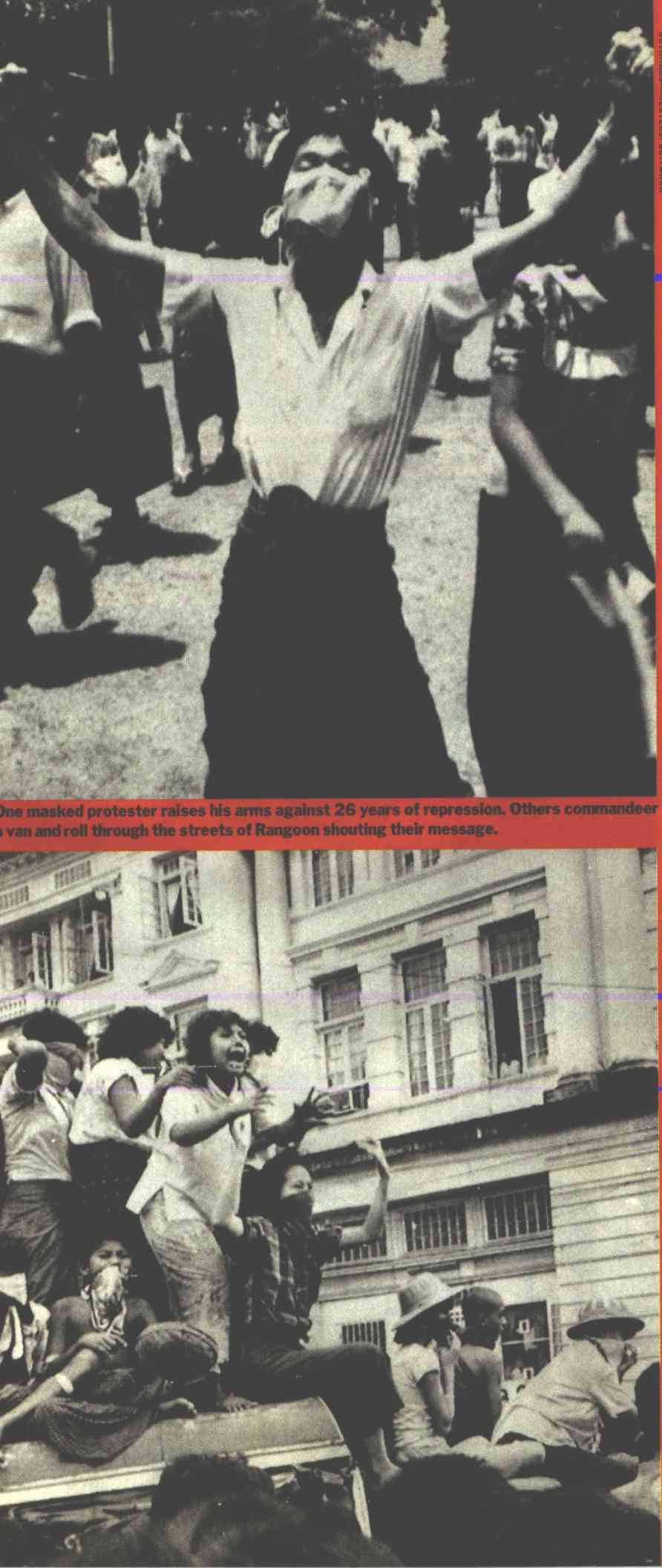
One of the few goals that animated Ne Win's regime was the continuation of four decades of sporadic warfare with a farrago of tribal armies on the country's periphery -- Karens, Kachins, Shans and others, all seeking local autonomy. Choked off at the center and fraying at the edges, Burma seemed primed for combustion.
Harbingers of trouble had appeared in the form of occasional protests for nearly a year, only to be quickly suppressed by security forces commanded by Sein Lwin, then the party's Secretary-General. Eventually the harsh tactics no longer sufficed. Ever strengthening tremors began two weeks ago, as larger and larger crowds, first of students, then of all manner of citizens, gathered at the Shwedagon Pagoda, the splendid golden shrine in North Rangoon, and the Sule Pagoda, in the center of the city. The first major quake struck early last week. In defiance of martial law, which Sein Lwin had decreed on Aug. 3, tens of thousands --perhaps more than had gathered for any other occasion since independence -- flocked to the streets of the capital in response to a general-strike call by students. Long columns of marchers, including hundres of Buddhist monks, strode through the city, shouting denunciations of Sein Lwin and bearing signs that proclaimed TO WIN DEMOCRACY IS OUR TASK. Similar demonstrations occurred in the least 16 cities and towns. Soldiers from the army's 77th Brigade, which had been deployed in Rangoon several days earlier, stood quietly away from the marchers, and the demonstration remained peaceful.
All that changed within a few hours. Late in the evening of Aug. 8, the 77th was replaced by the 22nd Light Infantry, a battle hardened division brought in from eastern Burma. Half an hour after the new unit took up positions in Rangoon, some of its soldiers opened fire on demonstrators; it is estimated that four were killed by the first volleys. Through the following day, the shooting against unarmed rallies continued. According to reports received by officials in Washington, the soldiers appeared to be acting on orders to fire: "There were well-organized bodies of troops roaming in the city, shooting at groups of demonstrators." Wherever troops -- sometimes backed by armoured cars -- appeared, crowds melted away, only to regroup somewhere else. Said U.S. official in Washington: "The fact that demonstrators were still in the street twelve hours after the demonstrations began implies there was a group of people willing die for their political beliefs."
The worst of bloodshed continued for 48 hours. At one point, after security forces barged into Rangoon General Hospital, several doctors and nurses who refused to hand over injured demonstrators were shot by the soldiers. Radio Rangoon boradcast news of the decapitations of the three policeman outside Rangoon, and announced that in North Okklapa, where two of the excutio9ns supposedly took place, 10,000 demonstrators had surrounded an army unit, causing more gunfire. The radio station later also reported that the Burmese air force dropped leaflets on North Okklapa saying that the town would be bombed if residents did not remove barricades blocking the unit's movement.
Still not spend, the violence spilled into yet another day; the following day Radio Rangoon reported 17 more deaths. A western diplomat described a tug-of-war over corpses: "When someone is killed, [the protesters] try to get it, so they can display the body, and the government tries to get ti to cremate i" -- and thereby destroy evidence of another death.
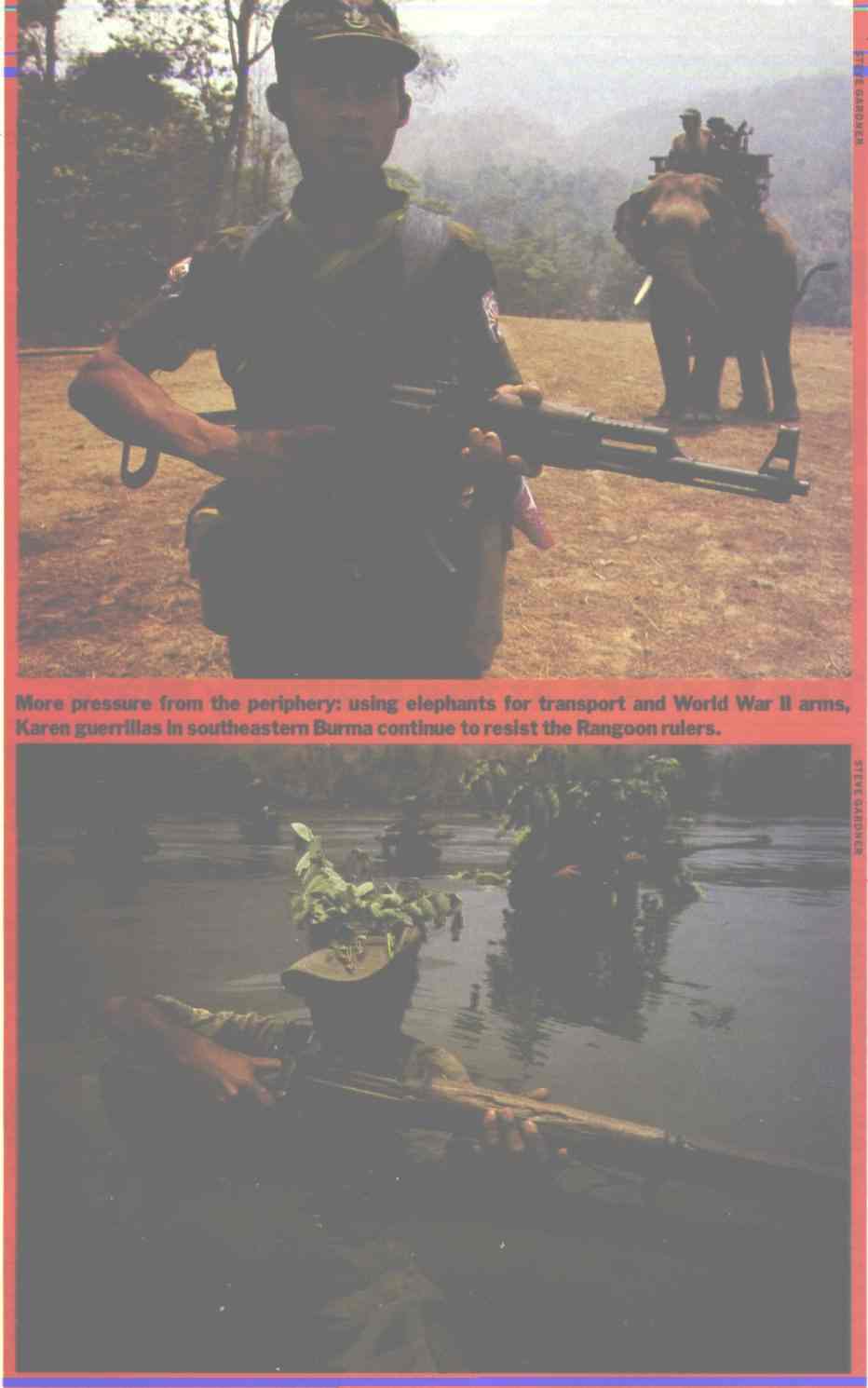
All the while, a windstorm of rumors swirled. Because of the regime's control of the press and the restrictions on foreign journalists, reliable information was sparse. Protesters, some reports claimed, had taken over Pegu, 45 miles northeast of Rangoon, and violence raged on in Mandalay, the capital in colonial days. And where was Ne Win, the man who before he resigned as leader on July 23 had seemed so unassailable? Rumor had it that the 78-year-old was honeymooning with his 25-year-old wife -- hs sixth -- at his magnificent villa on Inya Lake, about seven miles outside Rangoon, protected by 700 soldiers.
Most of the street talk, though, focused on the army, the likely linchpin of Burma's future. One story held that soldiers in the northeast were refusing orders to take part in the crackdown, another that troops in Pegu and other cities were joining the protesters. Army units in the central city of Toungoo were said to be fighting one another. The only statement about the army that was at all reliable came at midweek from its chief of staff, General Saw Maung, who pledged that troops would continue to use force to quell the unrest. He warned, "The people are now facing the anarchy of the violence makers."
From the periphery, meantime, some of the ethnic guerrillas who belong to the National Democratic Front, an antigovernment coalition that claims to have a total of 35,000 men and women under arms, announced that the tribal armies would join forces with the urban demonstrators. Brang Seng, a leader of the Kachin Independence Organization, called for an offensive to push government troops out of the cities. At the same time, Thai officials reported that Burmese soldiers in the southern province of Mergui had turned against the government.
When the announcement of Sein Lwin's departure finally came Friday, the relief was immediate. "Celebration and jubilation," was one Western diplomat's description, as people emerged form their houses, clapping and cheering. Through the night, shots were heard, but not nearly as many as earlier in the week. On Saturday crowds returned to the markets, looking to restock empty larders.
If the road to discontent began in 1962, when Ne Win led the military coup that ousted Prime Minister U Nu, the most careless turns on the path were taken during the past year. A critical one came last September, when the government decided to invalidate all 25-, 35- and 75-kyat notes. (The government-set exchange rate is 6.29 kyats to the dollar, but the prevailing black-market rate is closer to 45 kyats.) Designed to curb a ruinous inflation, then running as high as 100% a year on some commodities, and to punch a hole in a black market that significantly overshadowed legal commerce, the decree wiped out 60% of the country's currency -- and with it the savings and hopes middle-class Burmese. "That's when the regime lost all its credibility," says Josef Silverstein, an expert on Burma who teaches at Rutgers University. In response, outraged Burmese too to the streets to express their anger.
Visible disaffection with the Ne Win regime grew in March, when a fresh round of protests was brutally put down. The unrest, triggered by ta tea house brawl between pro- and antigovernment youths, was squashed by Sein Lwin's despised riot police, the Lon Htein, with as many as 300 demonstrators killed. The Lon Htein beat and robbed protesters and raped nine women; 41 detainees suffocated in a police van while being carted off to jail.
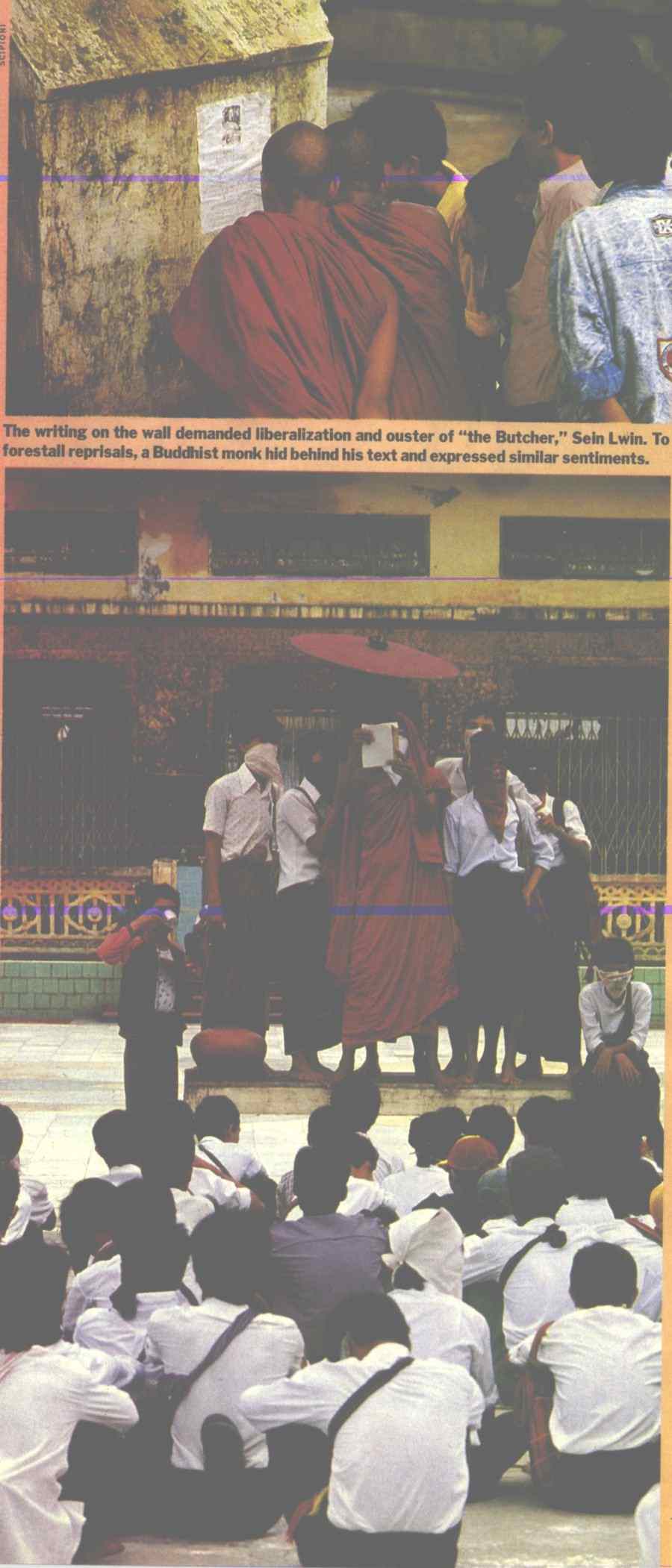
Though the demonstrations were quelled once again, economic troubles proliferated: by summer, daily life had become unbearable for many Burmese Takashi Shiraishi, a Burma scho9lar at Cornell University, visited the country two months ago and found a wasteland: "There is no medicine in the hospitals; you must buy your own on the black market at very high prices. Factories are running at 30% capacity. People do not trust the currency. Farmers are therefore not selling their rice, and the government rice-storage houses are empty."
Frustration began bubbling over following a session of the B.S.P.P. last month, a gathering that tantalizingly augured reform but delivered nothing of the kind. Ne Win had called the party congress a year ahead of schedule, purportedly bcause he was upset over the March riots and the continued unrest in June. At the session he stunned the delegates by offering his resignation for being "indirectly responsible" for the rioting. He also pushed a package of economic reforms unveiled earlier and proposed a national referendum on whether Burma should have a multiparty system. His resignation was accepted, but his proposal for a referendum was rejected --in part because party members had no desire to relinquish their privileges.
The final and most devastating blow came with the choice of Ne Win's successor. The announcement that Sein Lwin would assume the leadership of the B.S.P.P. caught Burmese -- as well as foreign observers -- by surprise and punctured hopes for political liberalization. Reason: Sein Lwin, also known as "the Butcher," was the man most identified with the repression of the Ne Win years. The link went back to 1962, when Sein Lwin, then an army captain and a fellow plotter in Ne Win's coup, commanded troops who massacred Rangoon University students opposed to the takeover. He became Ne Win's chief enforcer, and as commander of the riot police was believed responsible for the murderous excess of last March.
The reaction to Sein Lwin's ascendeancy was visceral. Explains Minoru Kiryu, a Japanese expert on Burma: "The public sentiment was "This is the one person we cannot forgive.'"
The succession itself provided one of the more puzzling aspects of developments in Burma, precisely because it appeared so outrageous. Western diplomats found the choice of Sein Lwin incredible because he seemed a likely scapegoat for the March and June restiveness rather than a beneficiary of those upheavals. Some analysts believed Sein Lwin's unexpected rise was a ploy by Ne Win to reestablish his mandate by showing how bad the alternatives were. Said a U.S. official: "Very few people think Ne Win has just retired from politics." Ne Win, argues Kiryu, wanted to leave office saying, "'I tried to build a democratic system, but it was voted down.' He wanted to create proof that the public didn't want it."
Whatever the explanation, the Sein Lwin appointment marked the breaking point for many Burmese. Matters were soon exacerbated when the new President ordered the arrest of retired Brigadier General Aung Gyi, the closest thing Burma has to an opposition leader. Along with Ne Win, Aung Gyi is one of the "30 Comrades" who led nationalist forces in the fight against British -- and then Japanese -- colonialism. He took part in the 1962 coup but was forced from the government the next year by more radical officials. In recent months, he sent Ne Win several open letters criticizing government corruption and incompetence, including that of Sein Lwin.
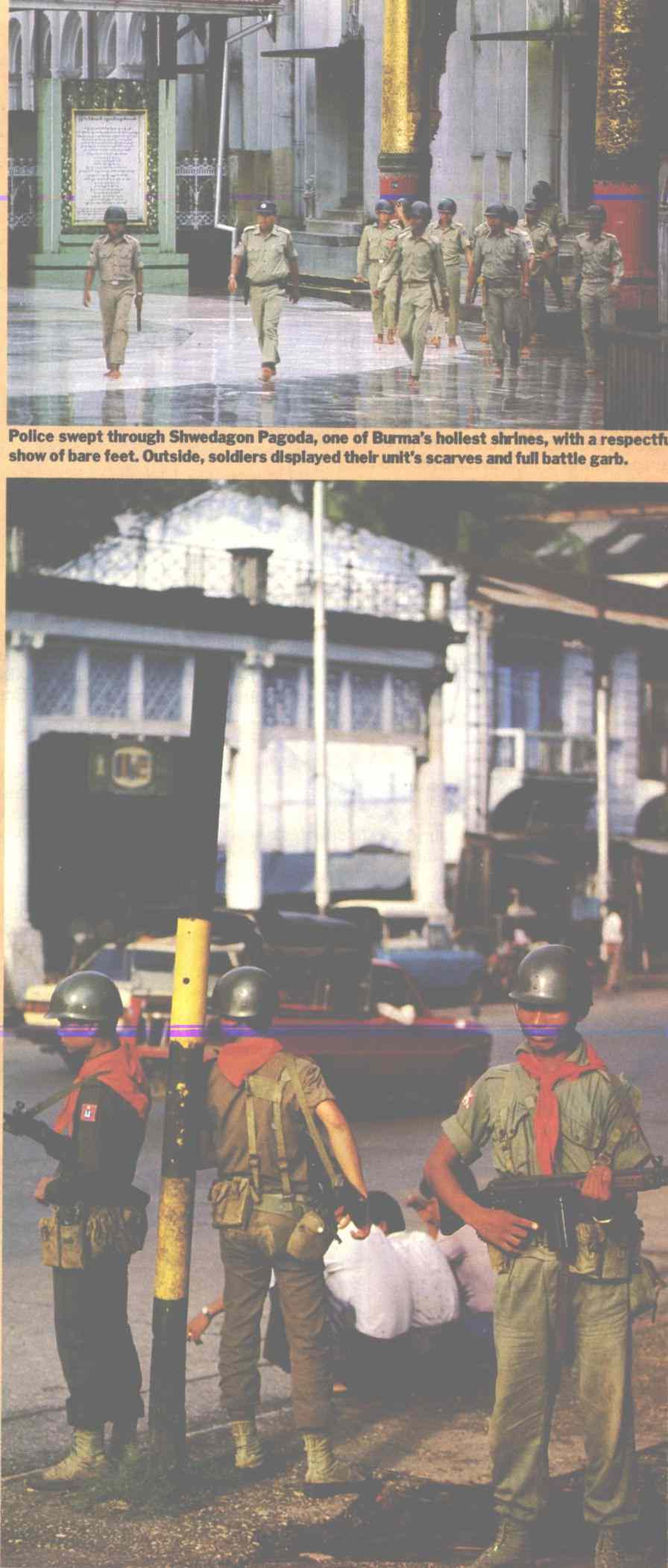
In the absence of a strong business class or a highly organized church -- both of which existed in the Philippines when Ferdinand Marcos was deposed -- the B.S.P.P. and the 163,000-man army it controls have monopolized political power, and it is from the military that new leadership will probably be drawn. "There are no alternative sources of power," says a Rangoon-based Western diplomat. A significant portion of the officer corps is well educated and shares the dissatisfaction of the middle class over the economic collapse. but since officers still enjoy a relatively high standard of living, they have something to lose if they part company with the B.S.P.P. -- a point Sein Lwin tried to underscore last week when, shortly before he stepped down, he gave military and other government personnel pay raises ranging up to 45%.
If the military asserts itself again, chances are the move will be led by younger officers, in the late 40s or early 50s, who are likely to take a less than favourable view of B.S.P.P. policies. Explains Kiryu: "Those in their 60s and older, who experienced foreign colonial control, understand the meaning of the Burmese Way to Socialism. They can feel its true meaning. But the younger people don't. They go home and see the poverty. They have started to question their society.
Whether or not the military will have to act could be decided by the party conference that starts Aug. 19. Resistance to the form from with the B.S.P.P. may still be so powerful that only superficial changes will be enacted, a move that might deepen the hostility of younger officers. Popular unrest could also prod the military to action. At week's end protesters and others on the streets of Rangoon were saying that one goal, the ouster of Sein Lwin, had been achieved, but another, the restoration democracy, had not. there was talk of a return to the barricades if the coming meetings did not accomplish that -- exactly the sort of pressure that could force the hand of the army. But the invigorating taste of what had already been accomplished brought courage to seek more. As one poster that began appearing around Rangoon Saturday proclaimed, WE ARE NOT SATISFIED.
-- by Daniel Benjamin, Reported by Jay Branengan/Bangkok, Kumiko Makihara/Tokyo and Jay Peterzell/Washington.
TIME/22 AUGUST 1988.



